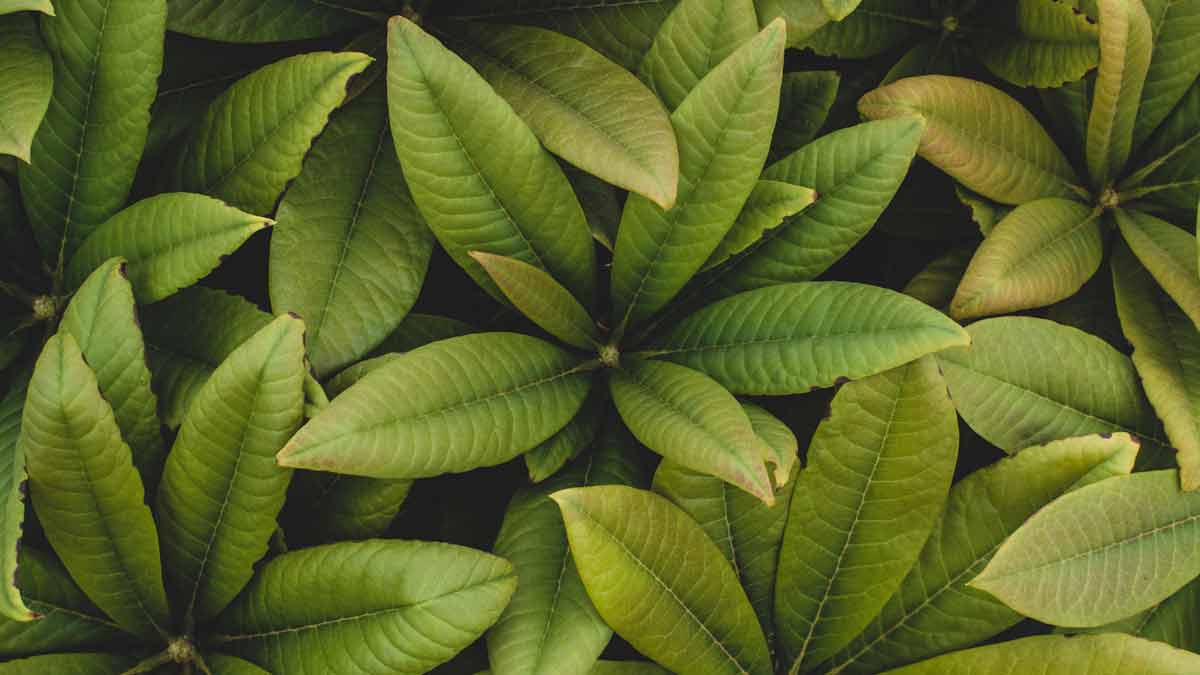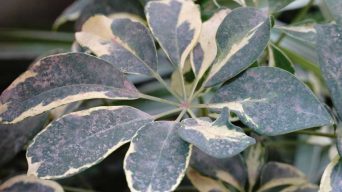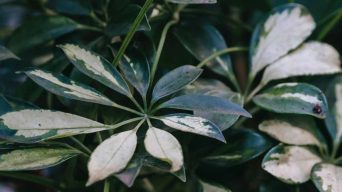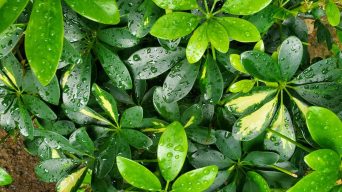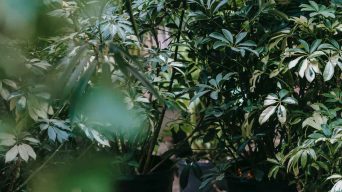Key Takeaways
- Schefflera leaves turning brown can be caused by overwatering, underwatering, poor lighting, low humidity, pest infestations, and nutrient deficiencies.
- To treat brown Schefflera leaves, prune affected areas, adjust watering habits to maintain consistent moisture levels in the soil, increase humidity levels around your plant and ensure proper lighting while treating any pest infestations and nutritional deficiencies.
- Regularly inspecting and addressing these factors will help keep your Schefflera healthy while encouraging new growth – make sure to dispose of dead foliage properly so as not to promote disease spread or attract pests.
Schefflera, also known as the umbrella tree, is a popular indoor plant prized for its low maintenance and striking foliage.
However, discovering your once-thriving Schefflera leaves turning brown without an apparent cause can be disheartening.
Here we will delve into the reasons behind this issue – from overwatering to pest infestations – and provide actionable solutions to help you restore your plant’s natural beauty.
Why Schefflera Leaves Turn Brown
There could be various reasons if you notice brown leaves on your Schefflera plant.
Some common causes include overwatering or underwatering, inadequate lighting, low humidity, pests, or lacking nutrients.
Overwatering
Overwatering is a common mistake many plant owners make, and it can be particularly detrimental to your Schefflera.
When the plant receives excessive water, it loses its ability to take in oxygen from the soil, which causes stress on the roots and ultimately leads to root rot.
Always use well-draining potting mixtures and pots with drainage holes to avoid overwatering your Schefflera.
Monitor the moisture level of your soil regularly by sticking your finger about an inch into the soil – if it feels moist or wet, hold off on watering until it dries out slightly.
Generally, Schefflera plants prefer to dry out a bit between waterings but should never be left completely parched for extended periods.
Be mindful that varying factors such as temperature, humidity levels, and sunlight exposure will also impact how often your Umbrella plant requires watering.
Underwatering
Underwatering is another common cause of Schefflera leaves turning brown.
When the plant isn’t receiving enough water, its leaves may become dry and crispy as they struggle to retain moisture.
To remedy underwatering, it’s essential to maintain a consistent watering schedule that keeps the soil evenly moist but not overly saturated.
A simple way to gauge when your Schefflera needs water is by checking the top inch of soil – if it feels dry, thoroughly water it, ensuring proper drainage so the roots don’t sit in standing water.
To further prevent underwatering issues and promote healthy growth overall, consider utilizing a humidifier near your indoor plants or placing them in rooms with higher humidity levels, like kitchens or bathrooms.
Poor Lighting
Poor lighting is a common culprit behind Schefflera leaves turning brown.
These tropical plants thrive in bright, indirect light, but exposure to direct sunlight can be harmful.
Intense sun rays can cause the leaves to scorch and turn crispy before eventually browning.
To maintain healthy Schefflera plants with vibrant green leaves, ensure they receive plenty of diffused light throughout the day – ideally near an east or west-facing window with sheer curtains for protection from harsh midday sunrays.
If natural sunlight isn’t an option due to your home’s layout or location, consider augmenting with fluorescent grow lights designed specifically for indoor plants.
Low Humidity
Schefflera plants can thrive in normal household humidity levels, but low humidity can cause their leaves to turn brown.
Dry air may be especially problematic when the indoor heating system runs in winter.
One way to combat this issue is by using a humidifier near your Schefflera plant or placing a tray of water nearby as it evaporates over time and adds moisture to the air.
Also, regularly misting your Schefflera with water can help increase humidity levels around it and prevent leaf browning caused by dry soil and low humidity levels.
Pest Infestations
Pest infestations are another common issue that can cause Schefflera leaves to turn brown.
Common pests include spider mites, aphids, and ants.
These pests can occur due to water deficiency in the plant, which weakens its natural defenses against insect attacks.
Signs of an infestation include webbing on the plant or small black dots moving around on the leaves.
To treat pest problems, isolating the infected plant and removing any dead or dying foliage is essential.
Using a mild insecticidal soap solution effectively controls spider mites and aphids.
Applying sticky traps around the plant can help catch ants or other crawling insects before they completely take over your Schefflera.
Nutrient Deficiencies
One common cause of Schefflera leaves turning brown is a lack of essential nutrients.
When your plant doesn’t receive enough nutrients, it can become weak and stressed, leading to browning and curling of the leaves.
Use a high-quality potting mix with balanced fertilizers to prevent nutrient deficiencies in your Schefflera plant.
You can also supplement with liquid fertilizers or slow-release granules for better absorption.
How To Treat Brown Schefflera Leaves
If your Schefflera leaves turn brown, you can take some steps to fix them.
You should trim the affected parts, change the watering routine, increase humidity, ensure adequate lighting, and address pest problems using insecticidal soap and fertilizer.
Pruning Affected Leaves
If you notice brown leaves on your Schefflera, it’s important to prune them as soon as possible.
This will improve the plant’s appearance and prevent any disease from spreading.
Here are some steps to follow when pruning affected leaves:
- Inspect the plant and identify which leaves have turned brown or crispy.
- Use sterile scissors or pruning shears to cut the damaged leaves off at their base.
- Make sure to dispose of these leaves properly, away from other plants.
- Avoid cutting healthy foliage, which can stress the plant and affect its growth.
Removing affected leaves promptly encourages new growth and prevents potential problems from spreading further throughout your Schefflera plant.
Adjusting Watering Habits
Adjusting your watering habits is one of the most critical steps in treating and preventing brown Schefflera leaves.
Here are some tips on how to do it:
- Only water the plant when 50-75% of the soil volume is dry.
- Water deeply and thoroughly, but avoid letting the plant sit in standing water.
- Use room temperature water and avoid using hard water or water containing high levels of minerals.
- Ensure proper drainage by having holes in your pot and using a well-draining potting mix.
- Consider using a moisture meter to manage watering more accurately.
- Avoid misting the leaves, as this can lead to fungal infections.
- You may need to increase watering frequency during hot summer but don’t overwater.
By following these simple tips, you can ensure that your Schefflera plant receives just enough water to thrive without experiencing brown leaves due to over or underwatering.
Increasing Humidity Levels
Increasing humidity levels is crucial to prevent Schefflera leaves from turning brown and crispy.
Here are some ways to increase the humidity around your plant:
- Use a humidifier: Setting up a humidifier near the plant is one of the easiest ways to increase humidity levels. You can adjust the settings to ensure that the air surrounding your Schefflera stays moist.
- Mist your plant: One of the simplest ways to increase humidity for Schefflera plants is to mist them with a spray bottle twice a week. This will add moisture to both the leaves and surrounding air.
- Create a pebble tray: By placing a layer of pebbles in a shallow tray and adding water, you can create an area of moisture around your Schefflera pot.
- Group plants together: Grouping indoor plants creates a microclimate that mimics outdoor conditions, elevating humidity levels naturally.
Increasing humidity levels around your Schefflera can prevent brown and crispy leaves caused by dry air.
Remember that keeping humidity levels balanced is essential as excess moisture can lead to other problems like fungal infections and pests infestations, so monitor it regularly.
Ensuring Proper Lighting
Proper lighting is a crucial factor in keeping Schefflera leaves from turning brown. Here are some tips to ensure your Schefflera plant gets the right light:
- Place your Schefflera plant in bright, indirect light. It means the plant should not be exposed to direct sunlight, which can cause leaf burn.
- A south-facing window with sheer curtains is ideal for keeping your Schefflera plant.
- If you don’t have a south-facing window, use artificial light sources, such as fluorescent bulbs or LED grow lights, for at least 12 hours a day.
- Rotate your Schefflera plant regularly to expose all sides to equal amounts of light and prevent it from leaning towards one side.
- If you notice brown spots on Schefflera leaves, move the plant away from areas with too much light and adjust the intensity using artificial light sources.
Treating Pest Infestations
Acting quickly is essential if your Schefflera plant suffers from a pest infestation.
Here are some steps to take:
- Isolate the affected plant: Move the Schefflera plant away from other plants to prevent the spread of pests to healthy plants.
- Prune heavily-infested parts: Remove all damaged, dead, or infested leaves, stems, or branches from the plant.
- Apply neem oil or insecticidal soap: Neem oil is an effective and natural pesticide that works against a wide range of insects like spider mites, aphids, and scale insects, which can infest Schefflera plants. Alternatively, spraying insecticidal soap onto the affected area can be used.
- Repeat treatment if necessary: Repeat the application of neem oil or insecticidal soap for several weeks until you have eliminated all pests from the plant.
Applying Fertilizer
Applying fertilizer is important for the healthy growth of Schefflera plants, but it’s crucial to avoid overfertilization.
Here are some tips on how to properly fertilize your Schefflera plant:
- Choose a balanced fertilizer: Use a balanced, water-soluble fertilizer with an N-P-K ratio of 20-20-20 or 10-10-10. This will provide the necessary nutrients without overloading the plant.
- Dilute the fertilizer: Mix the fertilizer with water according to the product instructions before applying it to your Schefflera plant.
- Apply once a month: Only fertilize your Schefflera plant once a month during the growing season (spring and summer). Avoid fertilizing during winter when the plant is dormant.
- Avoid overfertilization: Too much fertilizer can lead to brown and crispy leaves, root damage, and stunted growth. Stick to a regular fertilization schedule, and don’t be tempted to add extra.
- Flush out excess salts: If you suspect your Schefflera plant has been overfertilized, flush out excess salts by watering heavily until water runs out of the drainage holes in the pot.
By following these guidelines, you can keep your Schefflera plant healthy and green without causing it any harm from overfertilization.
Preventing Schefflera Leaves From Turning Brown
Following some key steps is important if you want to keep your Schefflera plant healthy.
Choose the right pot and soil, water the plant properly, provide adequate lighting and humidity levels, inspect it regularly for pests and diseases, and avoid placing it close to any heat sources.
Following these guidelines, you can prevent the leaves from turning brown and keep your Schefflera looking vibrant and fresh.
Choosing The Right Pot And Soil
Choosing the right pot and soil prevents Schefflera leaves from turning brown.
Ensure your plant has enough room to grow by choosing a pot with at least an inch of space around the root ball.
Good drainage is also crucial, so select a pot with drainage holes or add some if needed.
As for soil, ensure it is well-draining and rich in nutrients.
Using quality soil mixtures can significantly reduce the risks of overwatering.
It will allow water to drain out effectively while retaining just enough moisture for your plant’s roots to thrive without becoming waterlogged.
Watering Correctly
Proper watering is critical in preventing Schefflera leaves from turning brown.
Overwatering is one of the most common causes of brown and crispy leaves in Schefflera plants.
However, it’s not just about under or over-watering your plant; inconsistent watering can lead to brown spots on Schefflera leaves.
To water your plant correctly, soak the pot in warm water for a few minutes until the soil is thoroughly moistened, ensuring that all parts of the root ball are covered by water.
It’s vital to avoid letting your Schefflera sit in standing water, as this can lead to root rot and damage which will eventually cause irreversible harm to your beloved plant.
Regularly inspect the soil moisture level (stick your finger into the first inch or so) and adjust accordingly, whether you need to reduce or increase frequency depending on temperature, humidity, and season changes.
Providing Proper Lighting And Humidity Levels
Schefflera leaves can turn brown when they are not getting enough proper lighting.
They thrive in bright, indirect light and must be placed near a window with plenty of natural light.
In addition to proper lighting, adequate humidity is crucial for preventing Schefflera leaf browning.
These tropical plants require high humidity levels between 50-60% to stay healthy and lush, especially during the dry winter.
Dry air from heating systems or cold drafts can cause their leaves to dry out and lose moisture rapidly, turning brown.
Regularly Inspecting For Pests And Diseases
Inspecting your Schefflera plant for pests and diseases should be a regular care routine.
Here are some tips on how to do it effectively:
- Check the leaves for any signs of discoloration, spots, or holes.
- Look under the leaves and around the stem for any signs of insects, such as spider mites or aphids.
- Check the soil for any signs of insect or fungal infestations.
- Monitor the growth rate to ensure it is not stunted or abnormal compared to other healthy plants.
- Keep an eye out for any new growth that looks unhealthy or deformed.
By regularly inspecting your Schefflera plant, you can identify potential problems early and address them before they become more serious.
This will help prevent brown leaves and keep your plant healthy and thriving.
Avoiding Placement Near Heat Sources
Placing Schefflera plants near heat sources can lead to brown leaves due to hot, dry air exposure.
It’s important to avoid placing your Schefflera plant near heating vents, radiators, or other direct sources of heat, such as fireplaces and space heaters.
Extreme temperatures can also cause brown leaves in Schefflera plants, so keeping them away from areas with fluctuating temperatures, like drafty windowsills or doors, is best.
The ideal temperature for a Schefflera plant is between 60-75°F, and they can tolerate temperatures between 45-105°F without suffering from cold or heat damage.
Final Thoughts
Schefflera leaves turning brown can be caused by several factors, including overwatering, underwatering, poor lighting, low humidity, pest infestations, and nutrient deficiencies.
Treating brown Schefflera leaves involves:
- Pruning affected leaves and adjusting watering habits.
- Increasing humidity levels.
- Ensuring proper lighting.
- Treating pest infestations through the application of appropriate treatments like insecticidal soap.
Preventing your Schefflera plant from getting brown leaves means choosing the proper potting mixtures and soil and watering correctly while providing adequate lighting and humidity levels.

